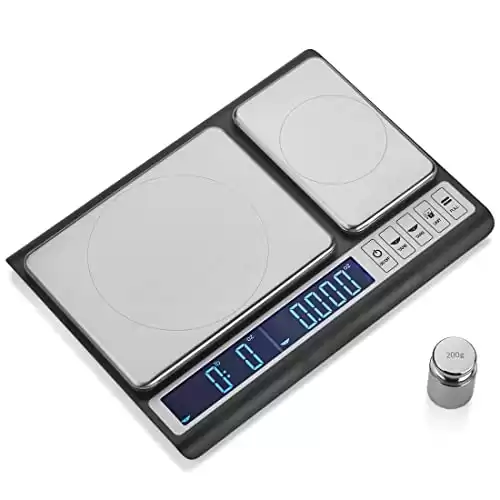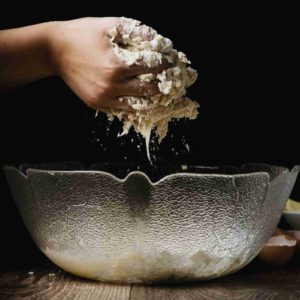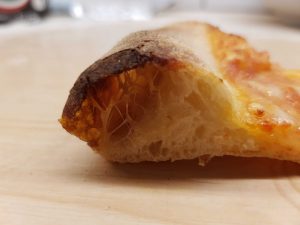To make good, consistent pizza, it’s essential to measure your yeast accurately. Using the right amount of yeast is going to make or break your pizza!
The key to good pizza is slow and steady fermentation. Over an 8-24 hour period, or more. But for a long, slow rise, you need small quantities of yeast. Often less than 1 gram. But how can you measure so small quantities of yeast? Especially when accuracy is so important?
The answer is: using a scale. But even if you don’t have a scale that’s accurate enough, there’s a solution!
Why it’s important to measure yeast accurately for pizza
Have you ever experienced that your dough doesn’t turn out the same every time? Then chances are that you didn’t measure your ingredients accurately.
The ingredients affect each other. So changing or measuring wrong can have a huge impact on your pizza dough. Especially yeast. Yeast is the magic ingredient that starts the fermentation process, which is what creates volume, consistency, and flavor in your dough.
If you add too much yeast the dough will ferment too fast. And as a result, it will lack flavor. You also increase the chance of over-proving. And shorten the window where the dough is ready for use.
If you use too little yeast, you will lack volume and flavor. The pizza will not rise and you’ll end up with a flat, dense, and dry crust with no flavor.
Read more about yeast and fermentation here.
Why using a scale when baking pizza is important
Using a scale is more accurate than measuring ingredients by volume. So using a scale will make better and more consistent pizza.
There are 3 problems with using volume instead of weight:
- Many volume measurements are not standardized
- It’s hard to read the volume accurately
- How compact the ingredients is packed will affect how much you use
A US cup isn’t the same as a UK cup. And your tablespoon is not the same as mine. So using cups and spoons and other volume measurements is not a good way to measure ingredients.
The second problem is that it’s hard to read the volume accurately. It’s almost impossible to measure exactly 1 cup, let alone 1.28 cups of an ingredient.
Another issue with volume is that the amount of an ingredient can be more or less than you think. So even if you’re able to read it 100% accurately. 1 cup of flour can range between 100g and 150g (50%) depending on the type of flour, how fine it is, and how compressed it is. So you can probably imagine how a dough that contains 50% more than the recipe asks for will turn out very differently.
Measuring ingredients by weight is always accurate. 100g of flour is always 100g of flour. No matter how fine or compressed it is. So using a gram scale is the way to go if you want to make consistent pizza dough.
You can read everything about scales for pizza baking here.
How to measure yeast using a scale
The easiest and most accurate way to measure yeast for your pizza dough is by using an accurate digital scale. Ideally, you want a scale that can read in 0.01g increments. Especially if you’re serious about Neapolitan pizza with long fermentation times (8-24 hours or more).
Unfortunately, most kitchen scales can only be measured in 1-gram increments. And many can’t read weights below 5 or 10 grams. This is not ideal for measuring yeast for your pizza dough.
But many accurate scales, that can read 0.01 grams, can only measure up to 100 grams. That’s too small for measuring other ingredients, such as flour. I therefore personally use the Smart Weigh Culinary Kitchen Scale, with two platforms, one for larger quantities (like flour), and one for smaller, like yeast. It gives you the best of both worlds on one kitchen scale!
An accurate kitchen scale with two platforms that can measure up to 10kg at only 0.01g. Perfect for measuring both pizza flour and yeast
Measuring your yeast on a digital kitchen scale is pretty straightforward. Simply place a small bowl, reset the scale, and sprinkle yeast until you reach the desired amount.
But what if you have a scale, but it’s not accurate enough? Do you need to buy a new scale just for pizza baking? No, you can use the yeast solution method to weigh smaller quantities using the scale you already own.
How to measure yeast without an accurate scale (the yeast solution method)
To measure smaller quantities of yeast than your scale can read, you can dilute the yeast in water. This way you get a water-yeast solution of e.g. 1 part yeast, 9 parts water, making the same amount of yeast 10x heavier.
The idea is to dissolve an amount of yeast you can measure into the water. Let me explain using an example.
Let’s say the recipe asks you to use 0.4g of yeast. But your scale can only make 1-gram readings. What you can do is make a solution of water and yeast. If you for example use 10g of yeast and 90g of water you’ll have a mix of 100g total with 10% yeast.
So if you want to use 0.4g of yeast, you need 4g of your mix (4g * 10% = 0.4g of yeast). And if you need 1.3, you use 13g of your diluted yeast. Simple!
The only thing you need to be aware of is to subtract the extra water you add from the total amount of water in your recipe.
How to make a yeast solution
- Add 10g of yeast to a measuring cup or another container that’s easy to pour from.
- Add 90g of water to the same container and mix until the yeast is dissolved
How to use the yeast solution in your dough
- Measure out 10x the amount of yeast mix your recipe asks for (if you need 0.4g of yeast, use 4g of yeast mix)
- Subtract the water from your mix from the water in the recipe (eg. 4g of yeast mix contains roughly 4g of water, so if your recipe says 500 ml, use 496 ml (500-4)
Related
- Ooni Turning Peel Review: The Best Peel for Home - April 15, 2024
- Gi.Metal Turning Peel Review: Is This the Ultimate Pizza Tool? - April 14, 2024
- Discover Pizza Mastunicola: The Story of the First Pizza - April 7, 2024


